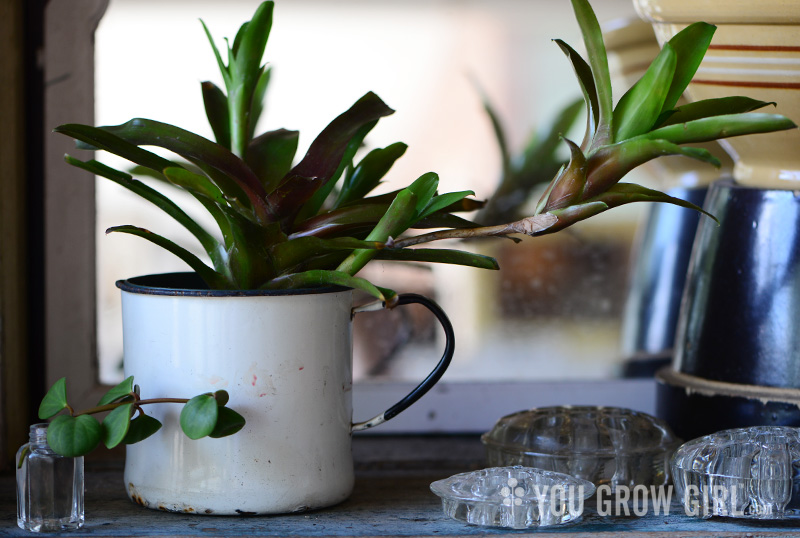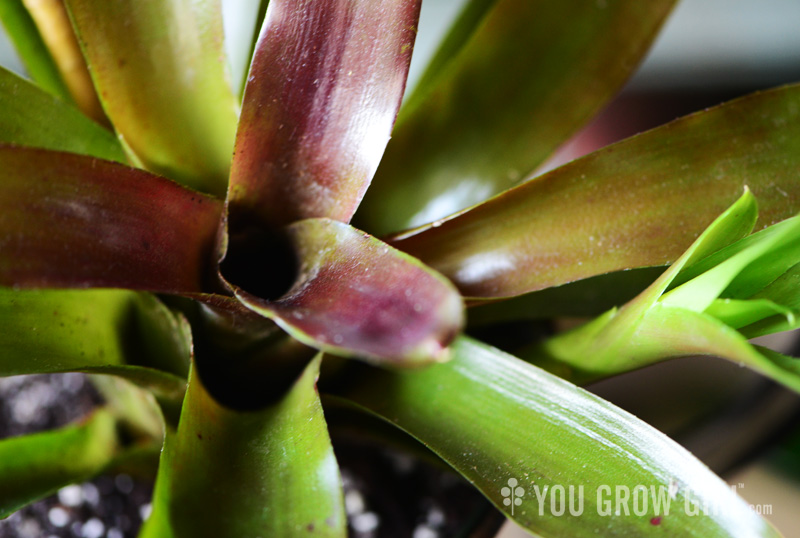
I spotted this gorgeous, burgundy and olive-leaved bromeliad, Neoregelia ‘Fireball’* is my best guess since there was no tag, while walking out of a corner shop last week (having just purchased a plant, of course). I loved that there were already pups underneath and a long arm extending out with a forth, larger baby attached. What beautiful form!
And then I thought about it everyday for a week.
Sometimes I’d mention it out loud to long-suffering Davin, who is the ear to most of my rambling plant talk, most especially the regrets. The talk started almost immediately. “How long would it take to walk back to the store to get that bromeliad?” And then later, “Remember that beautiful bromeliad?” “Why didn’t I get that bromeliad?” “Do I buy this item that I need, or do I get the bromeliad?”
So when, by happenstance, my weekly acupuncture appointment was moved to a location just down the street from the corner shop with said bromeliad, well, the rest of this story is predictable. I made a b-line for that shop directly afterward to get that bromeliad. And then I got home and found 2 small scale insects! Arg.
It was dark outside the shop where the bromeliad was so I didn’t have a chance to look closely. I don’t advise shopping for plants in the dark, but you’d be surprised by how many times I’ve done it. On two occasions it’s been so dark that I had to use flashlights. You’d think I’d be worried about being in a dark, outdoor plant shop at night, but apparently not. Too busy looking at plants.
I’ve been shifting my attention back to epiphytic plants again. I’ve kept a few rhipsalis and hatiora since moving from my old apartment 9 years ago, but somewhere along the line — somewhere in the decade between 2000 and 2010 — I lost all of the tillandsia and most of the bromeliads I once had. I had some rather large and fantastic ones, plants that are a pretty penny to purchase now. All were lost to time and memory, including a very large, silvery Aechmea fasciata aka Urn Plant that produced a scorching hot pink bloom and then died. There were pups that grew to maturity, but I eventually lost track of its progeny, somewhere around 2008. Lately, I’ve purchased a few small tillandsia impulsively when I have seen them on for $4 a pop at corner shops, and a small pot of baby staghorn ferns (Platycerium), and have taken to mounting them onto cork bark. I love how they look this way and have heard they do better when they have the chance to root onto wood as they do naturally in the wild. The creative process of mounting has brought my love of epiphytes back full force, and I’ve been contemplating getting more, which is risky considering the dry winter conditions in my home. We’re currently in the most humid time of the year and I am bolstered up by how they are thriving. However, it’s somewhat of an illusion as this is the easiest season to keep them alive. Once the drying forced air turns on in early October, and the bathroom, which is typically the most ideal place for air plants, gets too cold (this old place has cold and draughty pockets), it will be another story completely. I’m experienced with growing these plants indoors, which should be good for my confidence, but frankly, I am ignoring my own advice in trying to grow them again. I’d already planned to add a humidifier to the living room this year to help all of the other tropicals we’ve added, so hopefully that and regular care is enough. Live and learn.
What I will do about the scale insect:
- Keep plant away from other plants. This one will be going into a shady quarantine outside for now.
- Repot in more appropriate soil. While this bromeliad can be grown in terrestrial soil, it should be loose and well draining. The soil it came in is soggy, which is not good for the plant. That’s the hazard that comes with purchasing from corner shops that tend to apply the same care to all plants. Coir or orchid bark is a good option, but if those are hard to find, adding perlite to regular coir or potting mix in a 1:1 ratio will work in a pinch. I always have a bag of perlite on hand for that reason. Handy tip: you can find bags of bark chips in the reptile section of most pet stores.
- Check daily (especially in the crevices of the rosette), wipe leaves, and apply neem oil diluted with water if needed. You may recall that I purchased fresh neem stems from an East Asian food store in early July. None of the stems I attempted to root took, by-the-way. But the curry tree cuttings are holding on. However I did dry the rest of the neem and can now test out an infusion of that instead of bottled neem oil.

Growing Neoregalia and Aechmea Bromeliad as Houseplants
Care for Neoregalia and Aechmea bromeliads is extremely similar and both are mostly from Brazilian rainforests.
- These bromeliads are arboreal epiphytes, meaning they grow on trees, rather than in ground soil. However, they can be grown terrestrially, in pots. That said, their roots are shallow, whose purpose are more for affixing the plant to the tree.
- Bright indirect light such as an east or west window brings their colour out, but too much sun will burn them. Will also tolerate articifical lights.
- Neoregalias develop more colourful centres as they approach flowering. However, too much shade will also inhibit colour development.
- Like all epiphytic plants, they take in moisture and nutrients through their foliage primarily and so naturally prefer humid conditions. Mist leaves at least 3 times a week if you do not live in a humid climate, stepping it up if your home is dry like mine. A humidifier installed nearby is even better.
- Keep their urn or cup (their centre portion) 1/4 to 1/2 filled with filtered or distilled water. Use less in the winter and in spots with less than ideal sun. Allow cup to dry out slightly between watering and replace water monthly to prevent door and bacterial build up.
- Can be housed inside aquarium or vivarium tanks, but don’t really like smaller terrariums due to the lack of airflow.
- Soil: Well draining soil (water runs right through) is best. Use: orchid bark, coir bark, or regular potting soil (or straight coir) mixed 1:1 with chunky perlite. Since they get moisture and nutrients through foliage, you only need to keep the soil slightly moist, not wet.
- Once flowering, the main, mother plant will die off, but smaller pups or plantlets will appear alongside in her place. Eventually they can be separated and grown on. All can be mounted on cork bark or driftwood, but smaller pups are easier to mount.
- Fertilizing: I occasionally spray with sea kelp and/or fish emulsion weakened with a lot of water. Fertilize only during the growing season.
* I originally identified this as a smaller Aechmea ‘Burgundy’, but then realized it was likely too small, and the extended arms were a second give-away. That said, Neoregelia ‘Fireballs’ tend to be much brighter, but in this case the lack there-of can be explained by not enough light, or the age of the plant since, as mentioned above, neoregelia take on brighter colours as they approach the flowering stage. It’s a way to lure insects in before the big event.
However, I could still be wrong about the ID. The other hazard in purchasing plants from corner shops is that they are almost always unidentified. No matter, even without a name I know the proper care, and that’s the most important part!
When you posted this on IG last week I thought it was a ‘Fireball’, too, but didn’t mention it because I hate to be wrong. I’m glad my plant intuition might have been on the right track. We grew a nice specimen in Florida and sold it when we moved away and when I found some more through a vendor at a plant sale I had to have it—and now it is thriving on our porch. Definitely the portion getting more sunlight is bolder, the back part of the pot can be a lot more muted than the front part.
And I’m all for you diving into more epiphytes again—they are a favorite of ours.
I wish you had said! I don’t mind. I do my due diligence in making IDs but sometimes I’m just not sure and this was one of those times. I was so thrown off by it not being as bright as I expected until I happened upon a photo that showed one that looked very much like mine and I realized my mistake. It was a relief to get it right because having no ID or one I’m not sure about plagues me.
I so wish I still had some of the epiphytes I used to since it’s harder for me to get them now… and I have less money to blow. I think if I get it going again it will be a slow build.